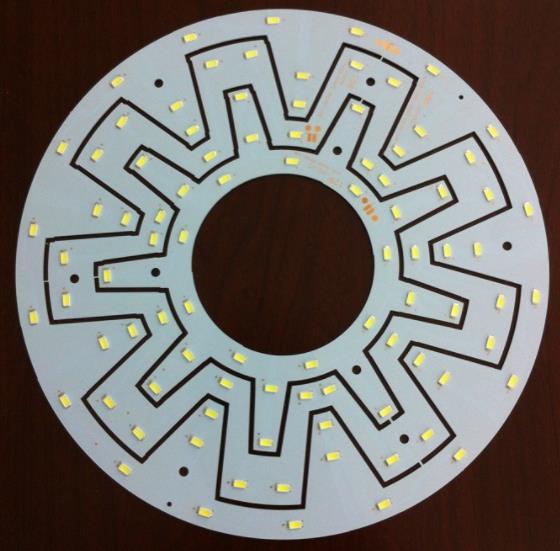1. What is aluminum pcb
Aluminum pcb is a kind of metal base copper clad plate with good heat dissipation function. Generally, the single panel is composed of three layers, namely, circuit layer (copper foil), insulation layer and metal base layer. For high-end use, there are also double-sided boards designed with the structure of circuit layer, insulation layer, aluminum base, insulation layer and circuit layer. Few applications are multilayer plates, which can be made of ordinary multilayer plates, insulating layer and aluminum base.

aluminum pcb
2. Layer structure of aluminum pcb
1) Line layer: The line layer (usually electrolytic copper foil) is etched to form a printed circuit for the assembly and connection of devices. Compared with traditional FR-4, aluminum pcb can carry higher current with the same thickness and line width.
2) Insulation layer: The insulation layer is the core technology of aluminum plate, which mainly plays the functions of bonding, insulation and heat conduction. The aluminum plate insulation layer is the largest thermal barrier in the power module structure. The better the thermal conductivity of the insulation layer is, the more conducive it is to the diffusion of heat generated during the operation of the device, and the more conducive it is to reduce the operating temperature of the device, so as to improve the power load of the module, reduce the volume, extend the life, and improve the power output.
3) Metal substrate: the metal used for insulating metal substrate depends on the comprehensive consideration of the thermal expansion coefficient, thermal conductivity, strength, hardness, weight, surface state and cost of the metal substrate
3. Difference between aluminum pcb and FR-4
The basic structure of the two kinds of plates is different in different main characteristics. Compare the main characteristics of aluminum plate and FR-4 plate: the heat dissipation of aluminum plate and FR-4 is compared with the heat resistance of the substrate: the substrate is aluminum plate, and theFR-4 plate is transistor PCB. Due to the different heat dissipation of the substrate, the test data of the working temperature rise are different.
1) Performance: the comparison of wire (copper wire) and fuse current on different substrate materials. From the comparison of aluminum plate and FR-4, due to the high heat dissipation of metal substrate, the conductivity is significantly improved, which explains the high heat dissipation characteristics of aluminum plate from another perspective. The heat dissipation of aluminum plate is related to its insulation thickness and thermal conductivity. The thinner the insulation layer, the higher the thermal conductivity of aluminum plate (but the lower the pressure resistance).
2) Machinability: aluminum plate has high mechanical strength and toughness, which is superior to FR-4. For this reason, large-area printed boards can be made on aluminum plates, and large components can be installed on such substrates.
3) Electromagnetic shielding: In order to ensure the performance of the circuit, some components in electronic products need to prevent the radiation and interference of electromagnetic waves. The aluminum plate can be used as a shielding plate to shield electromagnetic waves.
4) Thermal expansion coefficient: due to the thermal expansion of general FR-4, especially the thermal expansion of plate thickness, the quality of metallized holes and wires is affected. The main reason is that the thermal expansion coefficient of copper in the raw material is 17*106cm/cm-C, and the thermal expansion coefficient of FR-4 is 110*106cm/cm-C. The difference is large, and it is easy to produce heated substrate expansion, change of copper wire, and damage of metal hole fracture to product reliability. The thermal expansion coefficient of aluminum plate is 50 × 106cm/cm-C, smaller than ordinary FR-4, close to the thermal expansion coefficient of copper foil. This is conducive to ensuring the quality and reliability of printing FR-4. The FR4 plate is suitable for general circuit design and general electronic products due to different application circuits and fields.